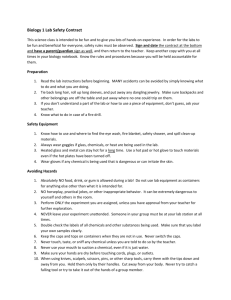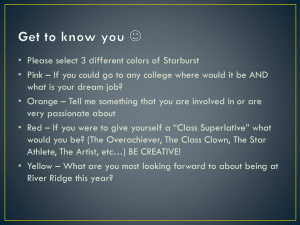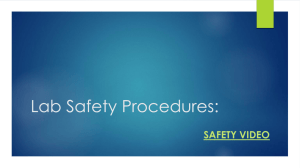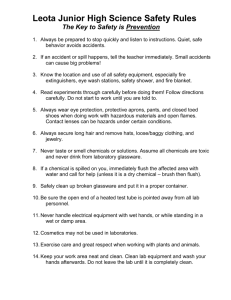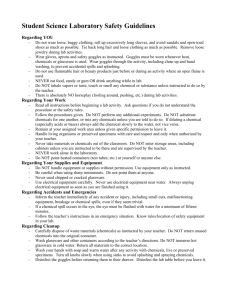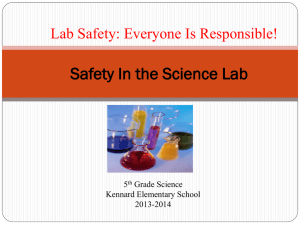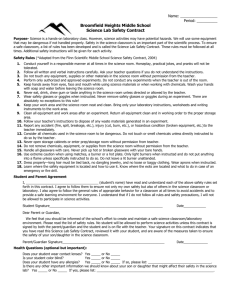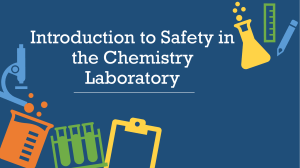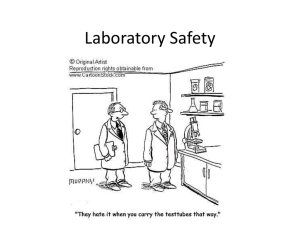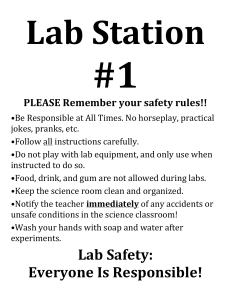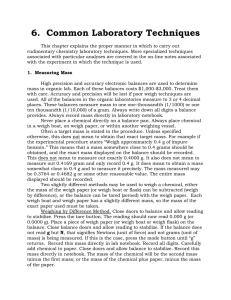Biology Lab Safety - Madison Public Schools
advertisement
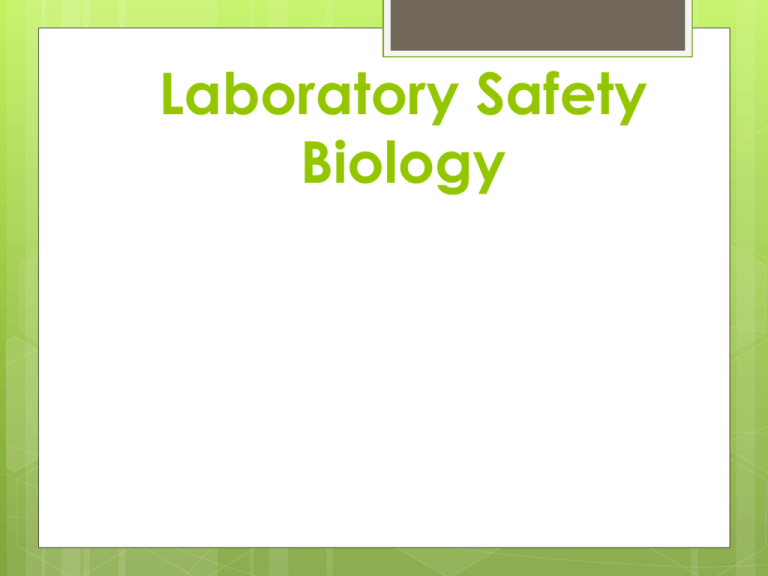
Laboratory Safety Biology Objective The student will demonstrate safe practices during field and laboratory investigation. Safety Rules NO food or drink in the lab. NO horseplay or loud voices in the lab. Keep workstation neat and clean. Understand what you are doing in the lab before beginning the lab experiment. Keep hands away from face while working. Know emergency procedures in case of an emergency. Work with a partner, but produce your OWN work. Wash your hands before leaving the lab. General Guidelines for Lab Safety Only perform experiments specifically assigned by your teacher. Understand safety rules before entering the lab. Tie back hair, roll up sleeves, put on and leave on, any required safety protective equipment for each lab. General Guidelines for Lab Safety Know the location of all safety and emergency equipment used in the laboratory. Immediately report and accident, incident, or hazard – no matter how trivial –to teacher. In case of fire, alert your teacher and leave the lab following given procedure. Do not eat or drink in the lab. General Guidelines for Lab Safety Do not fool around or horseplay in the lab. Do not apply cosmetics in the lab. Keep your work area neat and uncluttered. Clean your work area at the end of each lab period. REMAIN with your lab group. NO TABLE HOPPING. Eye Safety WEAR SAFETY GOGGLES as directed. Do not touch your eyes or face during lab and always wash your hands after performing a lab or activity. Emergency Eye Wash Station Immediately flush eyes with running water for 15 minutes. Hold eyes open with fingers to get under lid. Have lab partner notify teacher immediately. Safety with Gases or Inhalants Do not inhale any gas or vapor WAFT any scent to your nostrils ensure that you do not destroy the mucus membranes of your respiratory system. Handle materials that emit vapors or gases in a well ventilated area. Sharp-Object Safety Use extreme care when handling all sharp and pointed instruments, such as scalpels, sharp probes, and knives. Do not cut objects while holding them in your hand. Cut objects on a suitable work surface. Always cut in a direction away from your body. Heating Safety Hot plates look the same hot or cool. NEVER touch a hot plate to determine its temperature. ALWAYS assume hotplates are hot and treat them as such. Always inspect the electrical cord and outlet of a hotplate prior to plugging it in. Do not leave hot plates unattended. Be aware of flames, sparks, or heat before working with flammable materials. When heating chemicals or solutions in a test tube, do not point the test tube toward anyone. Avoid using open flames Know the location and use of the fire extinguisher and fire-safety blankets. Use tongs or insulated holders when handling heated objects. Hygienic Care Keep hands away from your face and mouth while working in the lab. Wash your hands before leaving the lab. Use proper technique when handling bacteria or other microorganisms. These are pathogens!!! Keep petri dishes sealed. Dispose of petri dishes as instructed by teacher for proper disposal. Wash hands after touching any cultures dish! Spill of caustic material on clothing Get to safety shower ASAP. Remove all clothing and rinse 15 minutes. Have partner inform teacher. Permanent skin damage can occur from chemical spills. Glassware Safety Inspect glassware for chips or cracks BEFORE using. Notify teacher immediately if glassware breaks. Do not attempt to pick it up with hands. Dispose of broken glassware in specified container. This container is a labeled bucket near the prep room door. Clean up and Proper Waste Disposal Clean and Sanitize all work surfaces and safety attire after each lab period. Dispose of all sharp objects and contaminated materials as directed by your teacher. Live Animals Always designate a SAFE ZONE for animals prior to working with them or removing them from their habitat. Notify teacher immediately if scratched, bitten or injured by a live animal. Examine the animals in their natural habitat first prior to working with them outside of their habitat. Always wash your hands after working with live animals. Treat animals with care and with respect at all times. Remain calm and plan all procedures ahead prior to exposing animals to procedures. Chemical Safety Always wear safety goggles, gloves, and a lab apron or coat when working with any chemicals. Do not touch, taste, or smell any chemicals unless instructed by your teacher. Know location of eye wash and shower stations. Do not mix any chemicals unless instructed to do so by your teacher. Do not pour water into a strong acid or base. Pour acid into the water. Your Turn! During lab you are an important piece of the puzzle; however, follow safety guidelines so that you do not stick out Lab Safety and Guidelines for Safety in Biology Exercise Lab Safety Project
